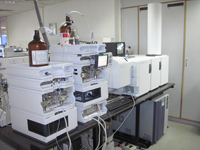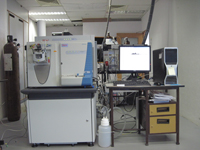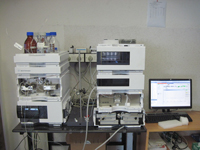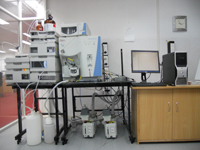Facilities |
|
|
Existing Facilities at IOB:
Laboratory For its current operations, IOB (established in 2002, recognized as a SIRO by DSIR in 2004 onwards, affiliated to Pondicherry, Amrita, Kuvempu and Manipal, KIIT Universities as a Research Centre for doctoral studies) has computational facilities, a molecular biology laboratory, a cell culture facility, immunohistochemistry platform, a mass spectrometry facility and a genomics laboratory. Using cutting edge technologies such as DNA microarrays and quantitative mass spectrometry, scientists at IOB are carrying out gene expression profiling, identifying genome copy number variations, profiling microRNA expression and studying methylation status on a genomewide scale. Proteomics methodologies such as GST pulldown assays, Western blotting and transfection studies are routinely used to study cellular signaling pathways. Molecular biology experiments include cell culture, DNA and RNA isolation, cloning and quantitative real time PCR to study signaling pathways in various cancers and neurological disorders. Using quantitative mass spectrometry, scientists at IOB are carrying out differential proteomic analysis in various cancers and neurological diseases to discover molecule associations and candidate biomarkers in these diseases. Using Agilent’s accurate mass Quadrupole Time-of-Flight mass spectrometer, IOB scientists have ventured into the emerging and evolving field of metabolomics. Metabolomics Facility: Metabolomics is steadily gaining momentum as a means to understand the complex biological systems in a better way. High-resolution mass spectrometry has become a fitting tool to this end. The metabolomics facility at IOB has a Quadrupole Time-of-Flight (QTOF) mass spectrometer with Dual Agilent Jet Stream Electrospray Ionization that boasts of high resolution (40,000X) and low femtogram sensitivity. It is currently the workhorse of the metabolomics unit at IOB. Using this tandem mass spectrometer coupled to a high performance liquid chromatography system, we have optimized the reversed phase and HILIC-based fractionation approaches to study a wider range of metabolite classes. At present, untargeted metabolomics on metabolites extracted from serum, urine and other body fluids as well as mammalian cell lines have been undertaken. Differential metabolite analyses using label-free quantitation methodologies have been applied to identify candidate metabolite biomarkers in body fluids. The TSQ Quantum Ultra, which is a high performance triple stage quadrupole mass spectrometer, which provides greater analytical selectivity. This mass spectrometer uses several different scan modes and enables constant neutral loss scanning, parent scanning, high-resolution precursor ion selectivity, Selected Reaction Monitoring (SRM), Highly Selective Reaction Monitoring (H-SRM) and Multiple Reaction Monitoring (MRM). TSQ Quantum Ultra is used to validate candidate biomarkers in CSF, serum, urine and other body fluids. Proteomics facility Scientists at IOB have optimized methods for nanoflow liquid chromatography, which is used in almost all proteomics experiments today. We have developed strategies for both online and offline multidimensional chromatography (MUDPIT) for extensive separation and fractionation of samples. We have pioneered the use of in vivo labeling strategies such as SILAC (stable isotope labeling with amino acids in cell culture), a technology that is currently being used by numerous groups around the world and are also experts in other quantitative labeling methodologies such as 18O labeling. A Fourier transform mass spectrometer with electron transfer dissociation capabilities (Orbitrap Velos with ETD) is an integral part of the Proteomics infrastructure at IOB. We are also equipped with reversed phase and strong cation exchange columns for protein/peptide fractionation. Computational facility Under the “DBT Programme Support on Neuroproteomics for Proteomic Investigation of Neurological Disorders,” IOB has setup a state-of-the-art computational infrastructure for the proteomics facility. The computational infrastructure includes a 64-Core Linux Cluster, 10 high-end Sun Fire Servers and a network attached storage server with 12 Tera Bytes of storage capacity. Additionally, 50 thin-clients which include 40 Linux workstations and 10 Windows Server workstations have been installed which share the central storage server. The Linux Cluster has been used for running algorithms for database searching of mass spectrometry derived data. The algorithms include Mascot and parallelized version of X! Tandem. The serial algorithm servers have been used for other database searching algorithms including OMSSA, Spectrum Mill, Inspect and SEQUEST. Additionally, this infrastructure is also used for development of a mass spectrometry data analysis pipeline BioDiscoverer. Library Facilities • A library with books of biomedical relevance • Availability of full text subscription for over 2500 biomedical journals • Weldoc facility for processing full text requests from journals not included in the above mentioned 2500 |

Agilent's Accurate-Mass Quadrupole Time-of-Flight mass spectrometer 
LTQ Orbitrap Velos mass spectrometer  High Performance liquid chromatography  TSQ-Quantum Ultra Triple Stage Quadrupole mass spectrometer |